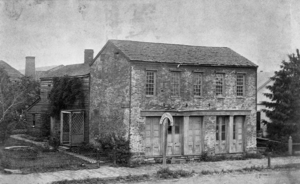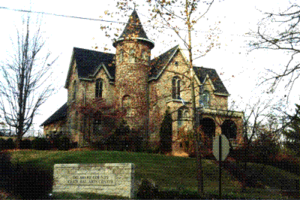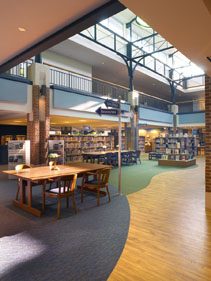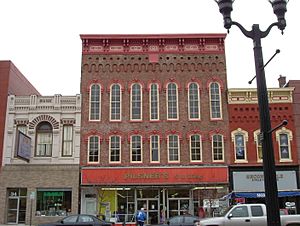Delaware, Ohio facts for kids
Quick facts for kids
Delaware
|
|
|---|---|
|
City
|
|
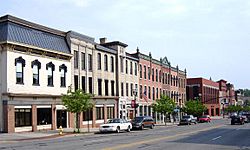
Downtown Delaware in 2007
|
|
| Country | United States |
| State | Ohio |
| County | Delaware |
| Founded | 1808 |
| Government | |
| • Type | Council–manager government |
| Area | |
| • Total | 19.92 sq mi (51.60 km2) |
| • Land | 19.80 sq mi (51.28 km2) |
| • Water | 0.12 sq mi (0.32 km2) |
| Population
(2010)
|
|
| • Total | 41,302 |
| • Estimate
(2019)
|
41,283 |
| • Density | 2,085.00/sq mi (805.04/km2) |
| Time zone | UTC-5 (Eastern (EST)) |
| • Summer (DST) | UTC-4 (EDT) |
| ZIP codes |
43015
|
| Area code(s) | 740, 220 |
| FIPS code | 39-21434 |
Delaware is a city in and the county seat of Delaware County, Ohio, United States. Delaware was founded in 1808 and was incorporated in 1816. It is located near the center of Ohio, is about 30 miles (48 km) north of Columbus, and is part of the Columbus, Ohio metropolitan area. The population was 41,302 at the 2020 census, while the Columbus-Marion-Chillicothe, OH Combined Statistical Area has 2,002,604 people.
Contents
History
While the city and county of Delaware are named for the Delaware tribe, the city of Delaware itself was founded on a Mingo village called Pluggy's Town. The first recorded settler was Joseph Barber in 1807. Shortly after other men started settling in the area (according to the Delaware Historical Society)- Moses Byxbe, William Little, Solomon Smith, and Elder Jacob Drake, Thomas Butler, and Ira Carpenter began building in the area. In 1808, Moses Byxbe built the first framed house on William Street. On March 11, 1808, a plan of the city was filed, marking the official founding of the town. Byxbe and the others planned the city to be originally on the east bank of the river, but was switched to the west bank only a few days after the first plan was filed.
Even though Delaware was still a small community, in 1812, when the capital of Ohio was moved from Chillicothe, Delaware and Columbus were both in the running and Delaware lost by a single vote to Columbus. However, following the War of 1812, settlers began arriving in Delaware in greater numbers. Among some of the earliest settlers were the parents of Rutherford B. Hayes, the 19th President of the United States. The Hayes home no longer stands, but a historical marker in front of a BP station marks the location.
In the early days of the town, a sulfur spring was discovered northwest of Joseph Barber's cabin. By 1833, a hotel was built as a health spa near the spring. However, the Mansion House Hotel was a failure, and by 1841, citizens began raising funds to purchase the hotel property with the intent of giving it to the Ohio and North Ohio Methodist Episcopal Conference of the Methodist Church for the purpose of a Methodist college. With that effort, Ohio Wesleyan University was founded in 1844.
Railroads came to the area in April, 1851 as Delaware served as a stop on the Cleveland Columbus and Cincinnati Railroad. Additional rail lines were added to serve Delaware providing access to major cities and markets throughout the country by the late 1890s. At the turn of the century, Delaware could boast of its own electric street railway system. In the early 1930s, electric inter-urban service was provided by the Columbus, Delaware and Marion system.
During the Civil War
During the Civil War, Delaware was the home to two Union training camps. The first on the west side of the river for white recruits of the 96th and 121st Ohio Volunteer Infantry were mustered into service. The second, on the east side of the river was for African-Americans joining the army in Ohio in the 127th Regiment of Ohio Volunteer Infantry - later renamed the 5th Regiment United States Colored Troops.
Geography
Delaware is located at 40°17′56″N 83°4′19″W / 40.29889°N 83.07194°W (40.298898, -83.072007).
The city is located about 24 miles north of Ohio's capital city, Columbus, due north along U.S. Route 23.
According to the United States Census Bureau, the city has a total area of 19.07 square miles (49.39 km2), of which 18.95 square miles (49.08 km2) are land and 0.12 square miles (0.31 km2) is water.
Demographics
| Historical population | |||
|---|---|---|---|
| Census | Pop. | %± | |
| 1810 | 200 | — | |
| 1820 | 369 | 84.5% | |
| 1830 | 527 | 42.8% | |
| 1840 | 898 | 70.4% | |
| 1850 | 2,074 | 131.0% | |
| 1860 | 3,889 | 87.5% | |
| 1870 | 5,641 | 45.1% | |
| 1880 | 6,894 | 22.2% | |
| 1890 | 8,224 | 19.3% | |
| 1900 | 7,940 | −3.5% | |
| 1910 | 9,076 | 14.3% | |
| 1920 | 8,756 | −3.5% | |
| 1930 | 8,675 | −0.9% | |
| 1940 | 8,944 | 3.1% | |
| 1950 | 11,804 | 32.0% | |
| 1960 | 13,282 | 12.5% | |
| 1970 | 15,008 | 13.0% | |
| 1980 | 18,780 | 25.1% | |
| 1990 | 20,030 | 6.7% | |
| 2000 | 25,243 | 26.0% | |
| 2010 | 34,753 | 37.7% | |
| 2020 | 41,302 | 18.8% | |
| Sources: | |||
2010 census
As of the census of 2010, there were 34,753 people, 13,253 households, and 8,579 families residing in the city. The population density was 1,833.9 inhabitants per square mile (708.1/km2). There were 14,192 housing units at an average density of 748.9 per square mile (289.2/km2). The racial makeup of the city was 90.6% White, 4.5% African American, 0.2% Native American, 1.4% Asian, 0.8% from other races, and 2.5% from two or more races. Hispanic or Latino of any race were 2.5% of the population.
There were 13,253 households, of which 35.9% had children under the age of 18 living with them, 48.7% were married couples living together, 11.7% had a female householder with no husband present, 4.4% had a male householder with no wife present, and 35.3% were non-families. 28.4% of all households were made up of individuals, and 9.4% had someone living alone who was 65 years of age or older. The average household size was 2.47 and the average family size was 3.04.
The median age in the city was 33.2 years. 25.5% of residents were under the age of 18; 11.8% were between the ages of 18 and 24; 30.5% were from 25 to 44; 21.1% were from 45 to 64; and 11.1% were 65 years of age or older. The gender makeup of the city was 48.0% male and 52.0% female.
Arts and culture
Notable places
Delaware is the location of Ohio Wesleyan University, one of the top liberal arts colleges in the United States and one of the Five Colleges of Ohio. The city is famous for The Little Brown Jug, an internationally famous harness race which is part of the Triple Crown of harness racing for Pacers.
Other notable places include:
- The Methodist Theological School in Ohio
- Perkins Observatory, offers many educational lectures, lessons in stargazing, and a library complete with astronomical computer programs.
- Delaware County Fair
- Delaware Municipal Airport Annual Air Fair
- The Delaware County District Library, website
- Staas Brewing Company
Main streets include:
- Sandusky Street, home to the downtown business district.
- University Avenue, covers most of the Ohio Wesleyan University campus.
- Winter Street, where a lot of cultural centers are located such as the Andrews House and The Arts Castle.
The life of the city
The Delaware downtown is a vibrant epicenter of the city. It boasts The Strand Theatre, the longest continually run movie theater in Ohio, nearly 20 restaurants, most with outdoor eating spaces. Quaint boutiques, antique shops, bookstores, yoga and dance studios are located amid floral shops, a record shop, cycling store, pre-prohibition style bar, micro breweries and a wide selection of specialty ice cream parlors, coffee shops, commercial banks, salons and spas. Visitors can shop the twice weekly farmers' market, wine store, brewer's supply house and beer emporium. Downtown Delaware has a main branch library, city hall, municipal courthouse and the county tourism bureau.
Delaware has maintained a traditional downtown shopping area, and added other shopping venues that includes the Delaware Commons pedestrian mall, a small mixed-use complex built at the end of the urban renewal era. This area contains an increasing number of large retail stores and restaurants run by national chains. Others say the chain stores boost local shopping options for residents considerably, many of whom would have previously shopped elsewhere, while increasing sales tax revenue for the city and county. The tradeoff between sprawl and economic development continues to be debated throughout the city and the surrounding area.
Delaware has many businesses characteristic of American university towns: used and new bookstores, a historical cinema, coffee shops, organic food stores, and local restaurants. The Arts Castle, home to the Delaware County Cultural Arts Center, offers classes ranging from ballet to fiber arts.
Delaware residents support a popular farmer's market[1], professional theaters, the Ballet Met, the Central Ohio Symphony Orchestra, Columbus Symphony, Opera Columbus, Contemporary American Theater Company, the Columbus Museum of Art, the Delaware Community Chorus and many theater opportunities. The city also hosts one of the main flea markets in the area every Sunday from 5am to 1pm. It is held at the Delaware County fairgrounds starting on April 1 and running every weekend until the end of October.
Historic Northwest District
Nestled between the Scioto and Olentangy rivers, just minutes north of Columbus, lies a hidden treasure. The Historic Northwest Neighborhood of the City of Delaware has it all: gorgeous historic homes on idyllic, tree-lined sidewalks, a short walk to excellent schools, delightful green spaces, a thriving downtown and one of the nation's premier small, private universities.
The Historic Northwest Neighborhood boasts more than 500 homes and carriage houses listed on the National Register of Historic Places, all recognized as worthy of preservation for local, state and national significance in American history and architecture. Each home, distinctively unique in character and style, takes you back in time and creates a deep appreciation for craftsmanship and history. From the earliest Federal style (c. 1826), to the modern Craftsman (c.1915) and the French Eclectic (c. 1930), the area includes Gothic Revival, Italianate, Second Empire, Folk Victorian, Stick, Queen Anne, Richardsonian Romanesque, Shingle, Prairie, Mission Tudor and Colonial Revival styles. Victorian mansions are just steps from the robust Downtown Historic District, where another 79 buildings are listed on the National Register.
Delaware's historic Northwest District, home to city founders and entrepreneurs in the 1800s, remains a time-tested, vibrant community and a great place to live. The Northwest Neighborhood incorporates the downtown business district and neighborhood Ohio Wesleyan University.
Sister city
A sister city partnership was signed May 13, 2011, by the Cities of Delaware and Baumholder, Germany, highlighting a four-day stay in Delaware by a Baumholder delegation, in which the guests established relationships with local government, business and educational leaders. The four-person delegation was led by Baumholder Mayor Peter Lang, who was joined by Deputy Mayors Michael Röhrig and Christian Flohr; and Council Member Ingrid Schwerdtner. Mayor Lang and Delaware Mayor Gary Milner, with their respective elected delegations looking on, signed a joint resolution, “holding the firm belief that this agreement will contribute toward the peace and prosperity of the world, and do hereby pledge to cooperate with each other as twin/sister cities.”
Baumholder and Delaware have had a relationship for more than 20 years, thanks to the Ohio Wesleyan University men’s soccer team. Every three years since the early 1990s, the team travels to Baumholder for a series of summer friendships games. Additionally, Baumholder is home to a 12,000-personnel U.S. Army garrison. With the partnership in place, the two cities now will focus on creating an educational and interactive environment for networking, sharing best practices and engaging elected officials.
Economy
There is a true economic mix in the area. The economic mix of the county reveals a balance of the following main economic activities: Manufacturing (18%), Trade (27%), Government (15%), and Service (23%) according to statistics published by Delaware Area Chamber of Commerce in 2000. The largest employers are in automobile coatings, plastics, copper products, education, insurance, automobile parts and distribution, sports apparel, retail, services, and government. Delaware County is a net importer of workers from throughout Ohio.
Packaging company Greif, Inc. is headquartered in Delaware.
Notable people
- Horace Newton Allen, U.S. diplomat
- Alexander Borteh, professional poker player
- Tyler Christopher, actor on General Hospital
- Cody Coughlin, NASCAR driver
- Cliff Curtis, baseball player
- Amos Dolbear, American physicist and inventor
- Francis Thomas Evans, Sr., pioneer aviator
- Charles W. Fairbanks, the 26th Vice President of the United States
- Arthur Flemming, former United States Secretary of Health, Education, and Welfare
- Lloyd Gardner, diplomatic historian
- Lucy Webb Hayes, First Lady
- Rutherford B. Hayes, the 19th President of the United States (1877–1881)
- Todd M. Hughes, Circuit Judge, U.S. Court of Appeals for the Federal Circuit
- Clare Kramer, Actress known for playing Glory, the Big Bad of season 5 of the TV series Buffy the Vampire Slayer
- Vincente Minnelli, motion picture director
- Branch Rickey, Major League Baseball executive
- Buck Rodgers, professional baseball player
- Frank Sherwood Rowland, a chemistry Nobel laureate
- Ezra Vogel, professor
- F.F. Schnitzer, architect of many structures of the National Register of Historic Places. Designed and constructed Delaware City Hall.
Images for kids
-
Campus clock in front of Ohio Wesleyan's Sturges Hall located near Sandusky Street
See also
 In Spanish: Delaware (Ohio) para niños
In Spanish: Delaware (Ohio) para niños


